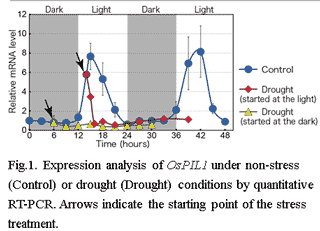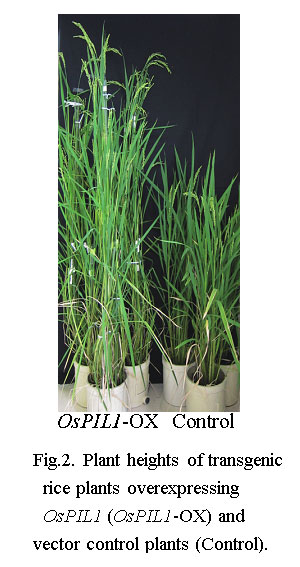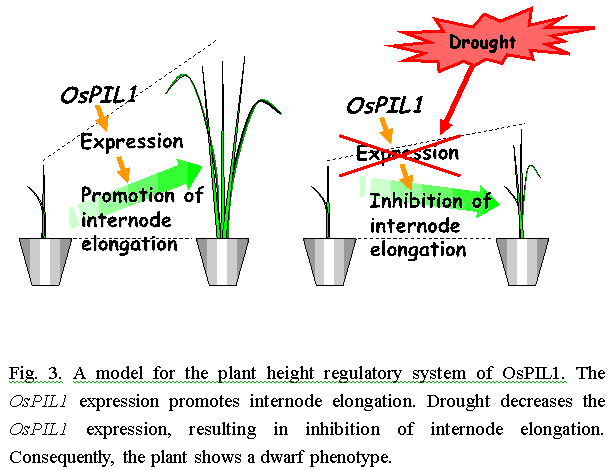Identification of a gene that regulates growth under drought conditions in rice
Description
Drought causes growth reduction in plants. Although drought changes expression of a variety of genes, the physiological and molecular mechanisms for plant growth restriction during drought conditions remain unclear. In this study, we identified a gene for a phytochrome (phy)-interacting basic helix-loop-helix transcription factor (PIF)-like protein, OsPIL1, which acts as a key regulator of reduced internode elongation in rice under drought conditions.
The level of OsPIL1 mRNA in rice seedlings grown under non-stressed conditions with light/dark cycles oscillated in a circadian manner with peaks in the middle of the light period (Fig. 1). When drought started in the middle of the dark period, expression of OsPIL1 was not elevated during the light period. When drought started early in the light period, the OsPIL1 expression was drastically decreased to a level similar to that observed in the dark period (Fig. 1). We found that OsPIL1 was highly expressed in the node portions of the stem using promoter-GUS analysis. Transgenic rice plants overexpressing OsPIL1 (OsPIL1-OXs) showed promoted stem elongation, resulting in a strikingly tall plant (Fig. 2). This was mainly due to increased elongation in each internode. In contrast, transgenic rice plants with a chimeric repressor (OsPIL1-RDs) displayed short internode sections. The internode cells of OsPIL1-OXs were larger than those of non-transgenic control plants. Smaller internode cells were found in OsPIL1-RDs. The transcriptome analysis identified 1396 genes up-regulated (FCA > 2.0) and 1358 genes down-regulated (FCA < 2.0) in the 1st node portion of OsPIL1-OXs. Expression of more than half of the up-regulated genes was decreased under drought conditions (790/1396 genes), and expression of large numbers of the down-regulated genes was increased by drought (480/1358 genes), suggesting that these were down-stream genes for OsPIL1. The up-regulated gene set in OsPIL1-OXs was enriched for cell wall related genes responsible for cell elongation. Using the transient assay system, we verified that OsPIL1 could activate expression of the cell wall related gene via the G-box element. These data suggest that OsPIL1 functions as a key regulatory factor of reduced plant height via cell wall related genes in response to drought (Fig. 3).
The regulatory system by OsPIL1 may be important for morphological stress adaptation in rice under drought conditions. We think that the OsPIL1 gene has great potential to produce crops with good growth even under drought conditions.
Figure, table
- Affiliation
-
Japan International Research Center for Agricultural Sciences Biological Resources and Post-harvest Division
- Classification
-
Administration A
- Research project
- Program name
- Term of research
-
FY 2012 (FY 2011-FY 2015)
- Responsible researcher
-
Todaka Daisuke ( Biological Resources and Post-harvest Division )
Nakashima Kazuo ( Biological Resources and Post-harvest Division )
KAKEN Researcher No.: 90343772Maruyama Kyounoshin ( Biological Resources and Post-harvest Division )
Fujita Yasunari ( Biological Resources and Post-harvest Division )
Shinozaki Kazuko ( Biological Resources and Post-harvest Division )
ORCID ID0000-0002-0249-8258 - ほか
- Publication, etc.
-
Todaka, D., et al. (2012) Proc. Natl. Acad. Sci. USA. 109(39): 15947-15952.
- Japanese PDF
-
2012_15_A4_ja.pdf68.33 KB
- English PDF
-
2012_15_A4_en.pdf214.04 KB



